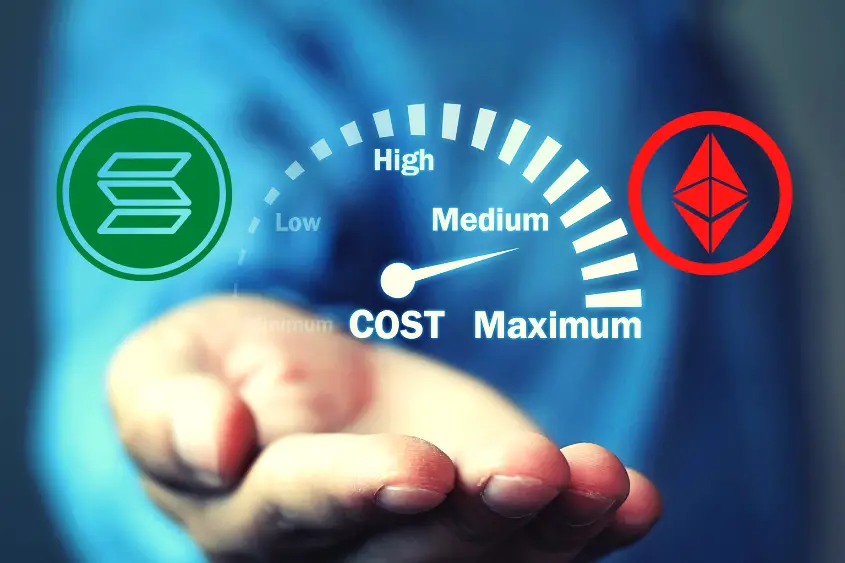Both Ethereum and Solana are two of the best blockchains when it comes to buying, selling, and minting NFTs. But which network is the best overall for NFTs?
Ethereum is the best blockchain for NFTs due to its popularity, security, and smart contract capabilities. Plus, its proof-of-stake upgrade will soon make it one of the cheapest and quickest networks. However, Solana is a great alternative considering it’s already cheap, scalable, and fast.
If you’re having a hard time deciding between Ethereum and Solana for NFTs, this article will cover every difference between the two blockchains.
Ethereum vs Solana NFT: Security
Ethereum is more secure than Solana. It’s 5 years older than Solana which means new security issues are less likely to be introduced. Also, Ethereum is considered to be more decentralized considering Everstake (Solana’s single biggest validator), controls more stake than half of the network’s validators combined.

Ethereum (Proof-of-Work)
Ethereum currently uses a proof-of-work (PoW) mechanism to secure its network. In simple terms, PoW requires members of the network to expend effort solving an arbitrary mathematical puzzle to prevent anybody from gaming the system. PoW is thought to be one of the most secure consensus mechanisms in blockchain technology.
PoW is also the reason why Ethereum remains so decentralized, as it allows for all transactions to be handled peer-to-peer without the need for an intermediary.
To be fair, Ethereum won’t be using its PoW consensus mechanism for much longer though as the network is currently in the process of being upgraded to a proof-of-stake (PoS) mechanism.
There are numerous steps to this upgrade which started in 2021 to ensure Ethereum remains one of the most secure blockchain networks. As a result, the upgrade likely won’t be completed until sometime in 2024.
It’s important to note that in the meantime, Ethereum’s security is not affected by the ongoing upgrade.
Solana (Proof-of-History)
Solana uses a Proof-of-History (PoH) timing mechanism that is implemented prior to facilitating its Proof-of-Stake (PoS) protocol structure. PoH is a consensus methodology that applies the measurement of time into a blockchain ledger with the intent of scaling and streamlining transactional throughput.
While most blockchains run without a timestamp, PoH acts as a decentralized clock, allowing Solana network nodes to execute transactions without committing processing power to resolve minor differences in time and order.
Though PoH enables Solana to function much quicker than Ethereum, it lacks security. In fact, DeFi safety, an independent DeFi rating organization, ranked Solana as the second-worst blockchain when it comes to security according to their technical standards.
Eth or Ether is the only cryptocurrency of Ethereum that can be used for making any payment. Also, thousands of collectible tokens or NFTs are stored and tracked on the Ethereum blockchain.
That being said, it’s safe to say that Ethereum NFTs are likely more secure than Solana NFTs overall.
Ethereum vs Solana NFT: Costs
The cost to create an NFT on Ethereum ranges from $50 to $150, whereas Solana’s mint price costs $0.04 to $0.12. Additionally, the average cost to purchase an NFT on Ethereum is around $1,400, whereas Solana NFTs generally sell below $1,000. Ultimately, Solana NFTs are less expensive than Ethereum.

Cost to Create NFTs on Ethereum
The reason why it costs much more to create an NFT on Ethereum is because of the gas fees. These are fees that are paid to miners for verifying and approving transactions on the blockchain.
Depending on how congested the network is at the time of creating an Ethereum NFT, you should expect to pay anywhere from $10 to over $150 to mint one NFT. This does not include marketplace fees which can range anywhere from 2.5% to 5% of the transaction price.
Furthermore, since Ethereum is the preferred NFT blockchain, it is known to host the most premium NFTs. For this reason, the largest NFT sales continue to occur on this blockchain.
Although the cost to mint and purchase NFTs on Ethereum is pricey right now, once the network upgrade is complete, the price to transact on the platform should lower significantly and as a result, should reduce the overall cost of NFTs on the network.
Cost to Create NFTs on Solana
The cost to create one NFT on Solana ranges from $0.04 to $0.12. The low gas fee is due to Solana’s consensus mechanism which ensures gas fees remain below $0.01 per transaction. As a result, the cost to create NFTs on Solana is greatly reduced.
Moreover, NFTs on Solana remain largely inexpensive because its network is not nearly as popular as Ethereum which means there’s not as much demand to buy NFTs on this network.
However, if you are just beginning to create your own NFTs and you don’t have a lot of money to spend, Solana remains a solid option for creators.
Average NFT Purchase Price on Ethereum
The average cost to buy an NFT on Ethereum ranges from $1,400 to over $4,600. This is mainly due to the popularity of the network and overspeculating brands on the network. That’s not to say that all NFTs on Ethereum are expensive. Some NFTs on Ethereum are free, with the exception of gas fees.
As the market continues to progress and becomes more mainstream, we will see NFTs become more affordable for all kinds of consumers. Also, the price of ETH affects the overall cost of NFTs on the blockchain so it’s hard to say exactly how much NFTs will cost in the future.
Eventually, I expect there to be a range of NFTs priced as low as one dollar to millions of dollars depending on what you receive with your purchase of the NFT.
For example, an NFT that acts as nothing more than a digital decorative piece created by an unknown artist might only cost you a few dollars. But once Lamborghini begins selling its exotic cars using NFT technology, obviously they will cost hundreds of thousands of dollars.
Average NFT Purchase Price on Solana
The average purchase price of an NFT on Solana ranges from $100 to $1,000. This is mainly due to there being a lack of creators on the network which results in minimum demand. Also, transaction fees are inexpensive so the cost to buy NFTs is lower compared to other networks.
That doesn’t mean that Solana doesn’t have great potential to be a leading NFT network, but as of now, it’s not nearly as popular as Ethereum which keeps the price of NFTs lower.
If you’re looking to purchase your first NFT in general or even your first Solana NFT, you can feel good knowing that you won’t have to spend an arm and a leg to get one.
Ethereum vs Solana: User Adoption
The success of a blockchain depends on how many people use the network.
Currently, Ethereum is the most preferred NFT blockchain with over 2 million users and more than $28 billion in overall NFT transaction volume. This is more than twice as many users and over 16 times the transaction volume of the Solana blockchain.

It’s no surprise that Ethereum is more popular considering it’s been around much longer than Solana, and it will always have that benefit over Solana and other newer blockchains.
Even though Solana may not be as popular as Ethereum, it still has a community of over 600 hundred thousand dedicated users, respectively. Obviously, it’s not as great as Ethereum, but there is still great potential to build something meaningful using Solana.
Whether you are considering investing or creating your own NFTs, you need to consider how many people use the blockchain network you’re considering using.
This is because the more extensive the platform is, the more opportunity you have to be successful. As an NFT creator, you want to choose a network that offers you more buyers, and similarly, buyers want to be on a network where they can find more sellers.
Ethereum vs Solana NFT: User Friendliness
One of the important factors to consider when comparing networks is their user-friendliness.
If a platform is too complicated to use, it will likely never reach mass adoption. And if a network fails to support the users’ needs, sooner or later, another network will occupy the space.
Ethereum is the most user-friendly NFT blockchain thanks to its many dApps and users. Since Ethereum is the most popular NFT blockchain, most of the innovation has occurred on this network. As a result, there are many tutorials and efforts to ensure Ethereum is easy to use for everyone.
These efforts include simple-to-use NFT marketplaces and minting platforms, software and hardware wallets for safely storing your digital assets, developers, as well as innovators & influencers who are dedicated to helping onboard others into the space.
When compared to Ethereum, Solana has several NFT marketplaces and wallets as well, however, Ethereum has more. Nonetheless, Solana’s ecosystem is still growing and is the fifth-largest cryptocurrency by market cap. So it’s not too far behind Ethereum, which is the second-largest cryptocurrency by market cap.
Ethereum vs Solana: Speed
Solana can handle up to 65,000 transactions per second (TPS) and hosts a swift 400-millisecond block time, making it one of the quickest NFT blockchains. This means transactions on Solana are almost instant and are much quicker than Ethereum’s current 15 TPS and 12 to 15-second block time.
Speed is one of the biggest advantages that Solana has over Ethereum. Unlike Ethereum, Solana doesn’t store data internally. As a result, it can power up to a theoretical 65,000 TPS.
This is an important factor for user experience, as a slow network translates to higher transaction fees. Since blockchain fees are calculated based on how busy the network is, it’s no wonder why Ethereum gas fees have the potential to rise above hundreds of dollars just to complete a transaction.
Though Solana is the obvious choice when it comes to speed. It won’t be that way for long. After Ethereum’s upgrade, it is thought that the network will be able to handle nearly 100,000 transactions per second.
In comparison, Visa handles approximately 1,700 transactions per second (based on a calculation derived from the official claim of over 150 million transactions per day).
So if it’s true that Ethereum will be able to handle anywhere near 100,000 TPS, it’s safe to say there should be no concerns about speed in the near future. Soon will be creating and buying NFTs faster than we complete an order online.
Which Is A Better Investment?
Ethereum NFTs are more valuable than Solana NFTs making them a better investment. Not only do NFTs on Ethereum date back further (making them more valuable), but most well-known creators and brands utilize this blockchain for their NFTs. Additionally, practically all blue chip NFTs exist on Ethereum.

In my opinion, you never know when an opportunity might arise though. Just because Ethereum has the most valuable NFTs today doesn’t mean that someone isn’t working on building something really cool right now, on Solana.
If you are curious to know how I find potentially good NFT investments, make sure to check out my collector’s buying guide. This will teach you everything to look for in a good NFT investment.
So, Should You Choose Ethereum or Solana For NFTs?
Choose Ethereum to either buy or create your own NFTs if you want to use a blockchain that is preferred and respected by the masses and if you have the means to do so. But, if you’re just starting out, Solana provides users an efficient and inexpensive experience on its network. Or, try both.
It’s hard to say which blockchain is the best for NFTs. That’s why trying each one out for yourself is the best option for determining the best choice for you and your needs. Of course, now you can take into consideration everything mentioned in this article to help make the best possible decision and know what to expect while using each network.
Overall, both Ethereum and Solana are two excellent networks for NFTs. Ethereum is the more popular and secure option. But when it comes to high speed and low fees, Solana is a newer network with huge potential.
